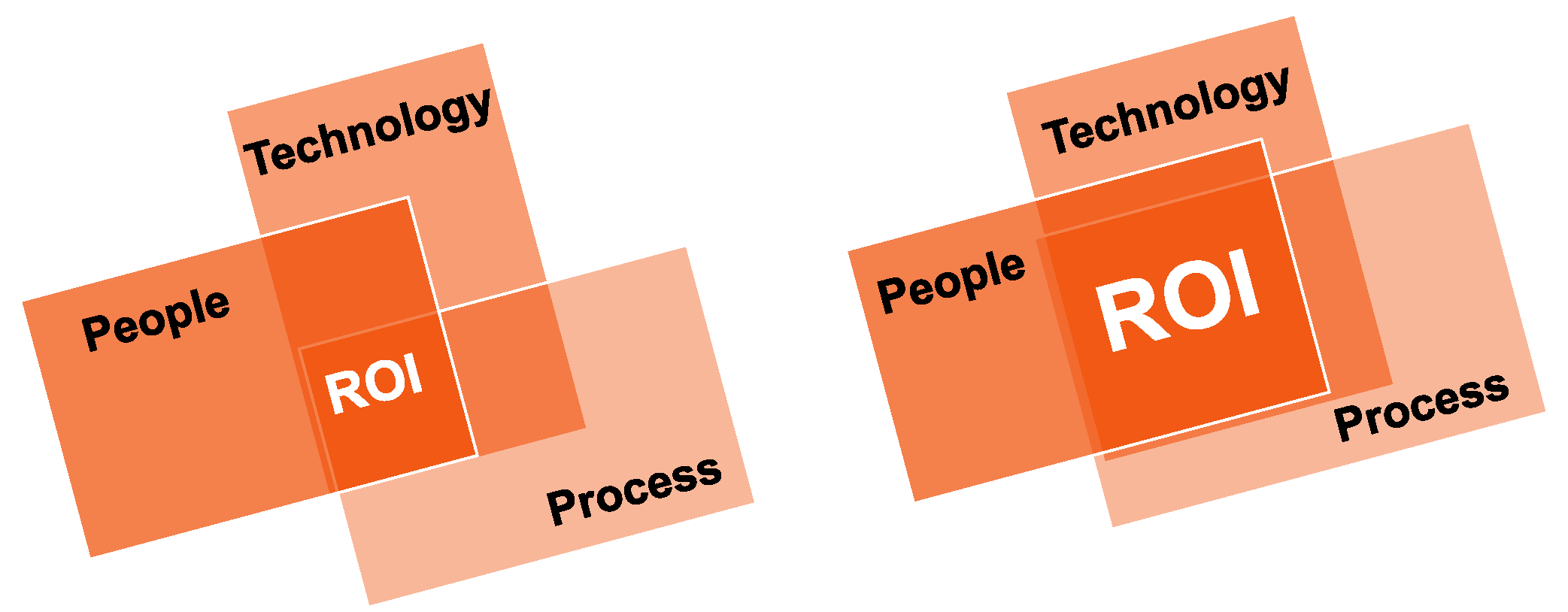Does your Process and Technology drive your People – or is it the other way around?

These three components can either be loosely aligned and yield lower ROI as shown in the Venn Diagram on the left, or more tightly aligned to yield higher ROI (diagram on the right).

As consultants, we focus on the Process and Technology components of the System, with the assumption that our work will improve the productivity of our client's People.
I like to say that Process LINKS People WITH Technology to FORM a System.
Recently, some client experiences have caused me to develop a variation of my previous statement – People DRIVE your System because they are the LINK between your Process and Technology.
The Two Meanings of "Drive"
I used the word "Drive" in the previous sentence because it does double duty.
- In one sense, Drive flips the notion that Process links People with Technology. Although it is true that Process – basically, a list of tasks or a collection of flowchart symbols – specifies how People and Technology SHOULD work together, People can, and sometimes do, choose to ignore the SHOULD and do tasks THEIR OWN WAY.
- In another sense, Drive refers to the overall result of a project – People can either make or break a project, meaning they DRIVE the project's value received by our client.
As consultants, we have no direct control over the People component of a client's System. We have to rely on the clients' managers and executives to ensure People conform to the Process we outlined and the Technology we developed.
Following are two examples that illustrate times when People can truly DRIVE your System's usage and its business value.
Clinging to a Homegrown Application
For one client, we developed a web-based application to replace a homegrown system well past its "Sell By Date." The People component for the new System was composed of two very different groups. One group of users enthusiastically embraced the new Process and Technology because they did not like the old System. The other group – extremely familiar with, and invested in, the old System – required more management attention.
For this second group, management tried many different ways to develop buy-in for the new Process and Technology and encourage its usage – all to no avail. Finally, management decided to pull the plug on the old system and force adoption of the new one. While there were some initial grumblings – mainly, that the new application's "look and feel" was not the same as the old one – the second group eventually got on board...because they had to.
With both groups now using the new system, they are jointly uncovering some uncommon scenarios not handled by the new application, and we are working with them to develop and implement the Process and Technology to handle these "edge cases."
Driving Numerous Changes with a System Implementation
For another client, we helped them select a new financial suite to replace their current one – which I can honestly say is the WORST such software I've ever seen, or could ever imagine, and that's saying a lot! Shortly after the selection project ended, the implementation project began.
Early in the implementation phase, I looked at the current financial processes, the structure of the chart of accounts, the data in the legacy system, the method employees used to record their time to projects, and the new way the Boards of Directors wanted these sister companies to work together and measure results. What I realized is that EVERY area I reviewed needed to be completely overhauled to achieve the overall project goals – and this is exactly what the executives wanted, for me to architect and build out a new way to run the entire business.
Fortunately, the great majority of folks in the Finance and Accounting area knew what they were doing needed to be changed – and they also knew they did not have the time, experience, or technical knowledge to revamp everything. Thus, they became willing partners in all the tasks needed to bring this future state to life. How willing were these folks? I had many weekday evening working sessions over Zoom with various people, along with some sessions over weekends.
We are currently working to scrub the previous fiscal year's data, to ensure we have good information to retroactively implement – as directed by the Boards – the new management agreement. It has been very gratifying for me to see these people use the variety of tools available through the new system to find and fix mistakes. They now have confidence in their ability to spot problems and fix both the mistake and the process that allowed the mistake to occur. I also sense a great pride in all they have accomplished, and in the improvements they can already see and plan to make.
People DRIVE Your System AND Your Results
This newsletter has focused on the "People" aspects of our work on two projects and, because people are, well, ... people, they are often the unknown, and perhaps unplanned, driver of your ROI. When you are in business long enough, you have either lived through, or could easily imagine, the twists and turns I described.
While both projects have been a long slog, forcing our clients and us to address issues neither was anticipating when the projects were initially launched, the clients' People are beginning to take the wheel and DRIVE things as designed. Because the people are using the Process and Technology we put in place, they are now DRIVING a significant return on our client's investment.
Sincerely,

Todd L. Herman






